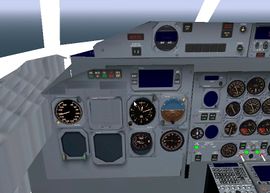Howto:Add instruments to a cockpit
| Work in progress This article or section will be worked on in the upcoming hours or days. See history for the latest developments. |
Many of the aircraft offerred for download on the FlightGear aircraft download page are detailled and complete. Some models, however lack instrumentation, and in many cases only basic instruments are available. Fortunately, adding new instruments is a relatively easy task. The biggest difficulty is actually placing the instrument accurately, not to get it working.
For aircraft that are licensed under the GNU GPL (all aircraft on the official downlaod page are), instruments can be re-used in other aircraft when released under the same license.
Adding instruments to existing models
Adding instruments consists of a few major steps:
- Identify the instrument needed to be added. Search the web for images and descriptions.
- Locate an aircraft with a similar instrument.
- Copy the instrument files into the folder of the aircraft you want to update.
- Edit the file that specifies the instrument and its location.
An example
Let's update the instruments of the Dash 8-300Q for a start.
The existing aircraft, version v20101217 from the version 2.6 aircraft download page has the following set of basic instruments ( Radios will be covered later):
- Air Speed Indicator (ASI)
- Altimeter
- Artificial Horizon
We can see that our aircraft is lacking the following:
- Vertical Speed Indicator (VSI)
- (certain other instruments that will be covered later)
Let's add the VSI. Open the Beech 1900D aircraft folder and locate the VSI instrument under the models folder. There should be an RGB or PNG image file with the dial of the VSI and other files starting with VSI. Copy these files to the instruments folder of the Dash 8.
Next we have to edit the file specifying the location of the instrument. This is in the dash300Q.xml file or similar under the Models folder. Locate the section listed as instruments.
Now for the interesting part. Locating the instrument is the most difficult part, and is often confusing. There is a shortcut, however, as FG allows you to create several copies of the same instrument at different locations in the cockpit or on the panel.
We will use the ASI as the reference point. Add the VSI on top of the ASI for the moment.
ASI location points will be listed as follows:
<x> <y> <z>
Copy the ASI section with the tags, that is including the <model> upto the </model> tags Next edit the section that refers to the ASI as follows:
Leave the VSI in the position it is in the B1900d folder as it is, and do no edit the location yet. this is to avoid mistakes
You will find that the VSI, the new instrument will appear on top of the existing one. This shows that the instrument at least appears in the cockpit. It has to be located, next.
- X: specifies the depth, and in this case is a negative value. The increase in the value, say from -2.330 to -2.430 means the instrument will move away from you into the panel, towards the nose of the aircraft.
- Y: is the simplest, here, and simply specifies left/right values. The pilot ASI is listed with an Y value of -xxx. The value of zero means it is centre in the panel. You will notice the the co-pilot's ASI has a positive value of xxx.
- Z: gives the position of the instrument in the vertical direction. For example 2.223 will place the instrument higher than 2.123 in the panel.
FlightGear allows the creation of the same instrument copies in different locations in the cockpit. We can use this to our advantage: placing copies of the same instrument in different locations in the cockpit and selecting the right one.
External link
- Flight instruments (Wikipedia)
